Comparative Analysis of Global Marketing: Japan & New Zealand Report
VerifiedAdded on 2022/05/20
|17
|4179
|32
Report
AI Summary
This report provides a comprehensive analysis of the marketing landscape in the global context, specifically comparing and contrasting the markets of Japan and New Zealand. It delves into various aspects, including regulatory differences, currency and economic factors, and transportation systems, highlighting how these elements impact marketing initiatives. The report further examines the effects of tariffs and trade agreements, such as the CPTPP, on the marketing plans of organizations, emphasizing the competitive advantages and challenges faced. Cultural differences and communication needs are also explored, recognizing their significance in shaping effective marketing strategies. The report identifies issues that organizations from New Zealand must address when entering the Japanese market, such as lack of market knowledge, communication barriers, and cultural differences, and proposes solutions. Overall, the report offers valuable insights into the complexities of international marketing, providing a framework for organizations to develop and implement successful strategies in the global market.
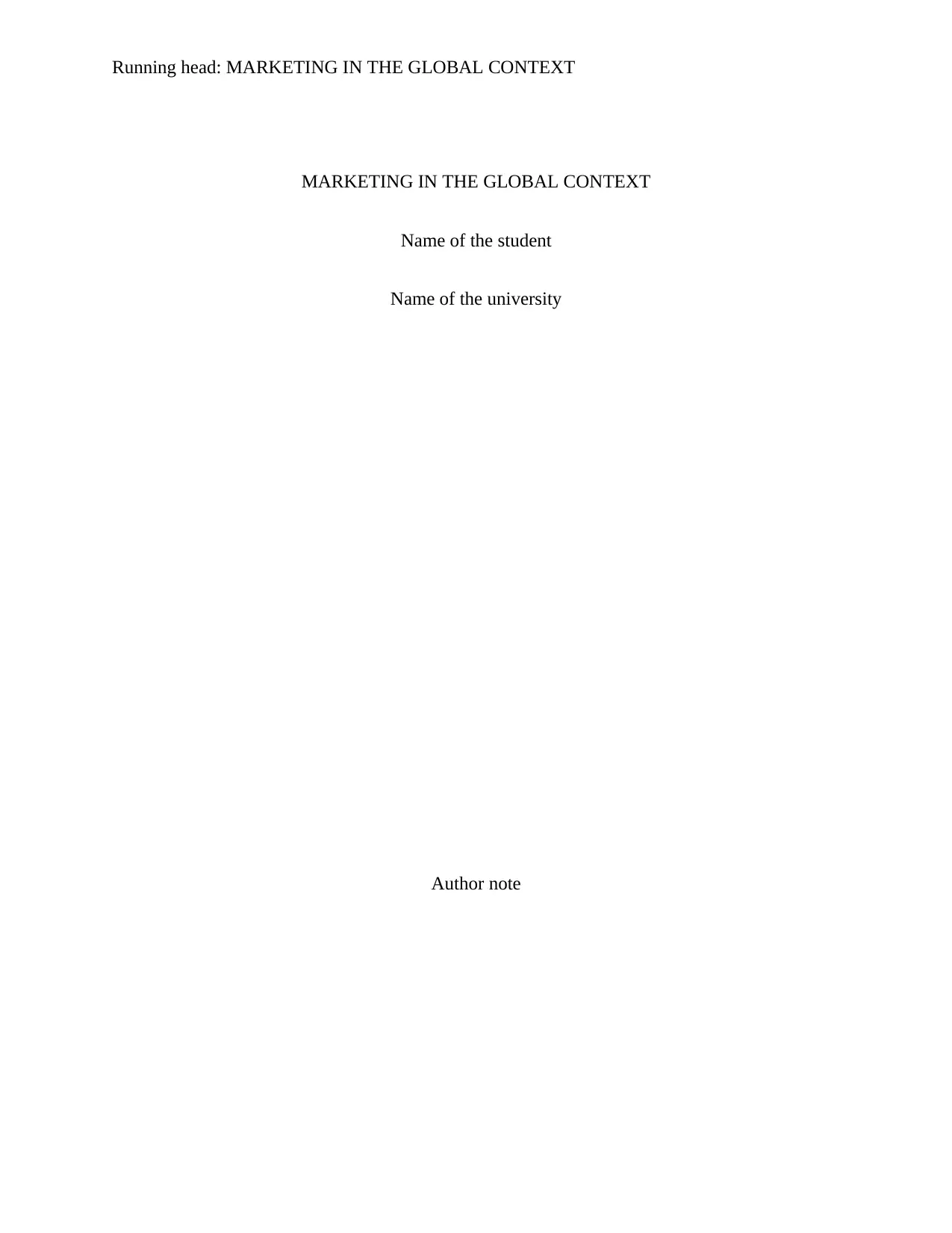
Running head: MARKETING IN THE GLOBAL CONTEXT
MARKETING IN THE GLOBAL CONTEXT
Name of the student
Name of the university
Author note
MARKETING IN THE GLOBAL CONTEXT
Name of the student
Name of the university
Author note
Paraphrase This Document
Need a fresh take? Get an instant paraphrase of this document with our AI Paraphraser
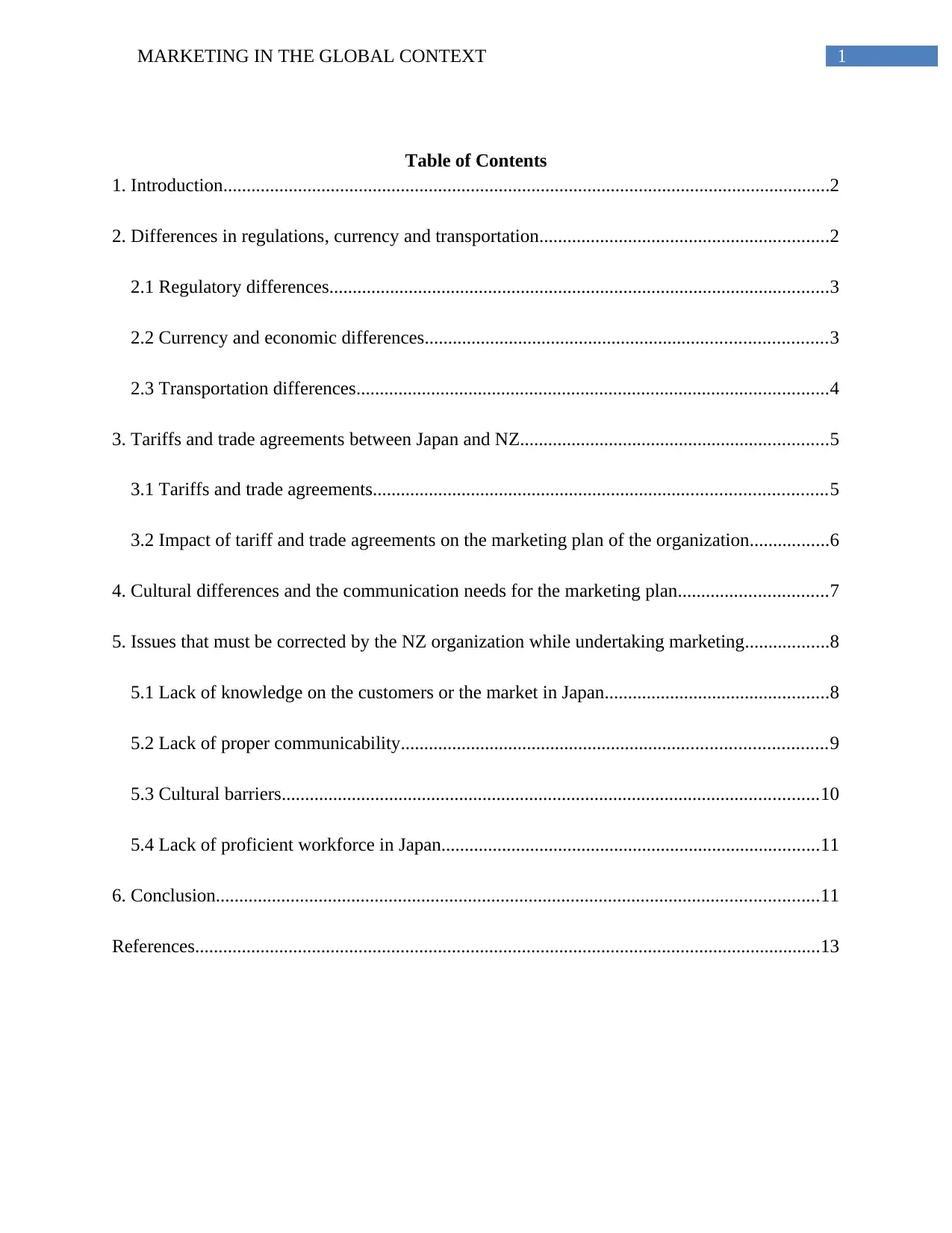
1MARKETING IN THE GLOBAL CONTEXT
Table of Contents
1. Introduction..................................................................................................................................2
2. Differences in regulations, currency and transportation..............................................................2
2.1 Regulatory differences...........................................................................................................3
2.2 Currency and economic differences......................................................................................3
2.3 Transportation differences.....................................................................................................4
3. Tariffs and trade agreements between Japan and NZ..................................................................5
3.1 Tariffs and trade agreements.................................................................................................5
3.2 Impact of tariff and trade agreements on the marketing plan of the organization.................6
4. Cultural differences and the communication needs for the marketing plan................................7
5. Issues that must be corrected by the NZ organization while undertaking marketing..................8
5.1 Lack of knowledge on the customers or the market in Japan................................................8
5.2 Lack of proper communicability...........................................................................................9
5.3 Cultural barriers...................................................................................................................10
5.4 Lack of proficient workforce in Japan.................................................................................11
6. Conclusion.................................................................................................................................11
References......................................................................................................................................13
Table of Contents
1. Introduction..................................................................................................................................2
2. Differences in regulations, currency and transportation..............................................................2
2.1 Regulatory differences...........................................................................................................3
2.2 Currency and economic differences......................................................................................3
2.3 Transportation differences.....................................................................................................4
3. Tariffs and trade agreements between Japan and NZ..................................................................5
3.1 Tariffs and trade agreements.................................................................................................5
3.2 Impact of tariff and trade agreements on the marketing plan of the organization.................6
4. Cultural differences and the communication needs for the marketing plan................................7
5. Issues that must be corrected by the NZ organization while undertaking marketing..................8
5.1 Lack of knowledge on the customers or the market in Japan................................................8
5.2 Lack of proper communicability...........................................................................................9
5.3 Cultural barriers...................................................................................................................10
5.4 Lack of proficient workforce in Japan.................................................................................11
6. Conclusion.................................................................................................................................11
References......................................................................................................................................13

2MARKETING IN THE GLOBAL CONTEXT
⊘ This is a preview!⊘
Do you want full access?
Subscribe today to unlock all pages.

Trusted by 1+ million students worldwide
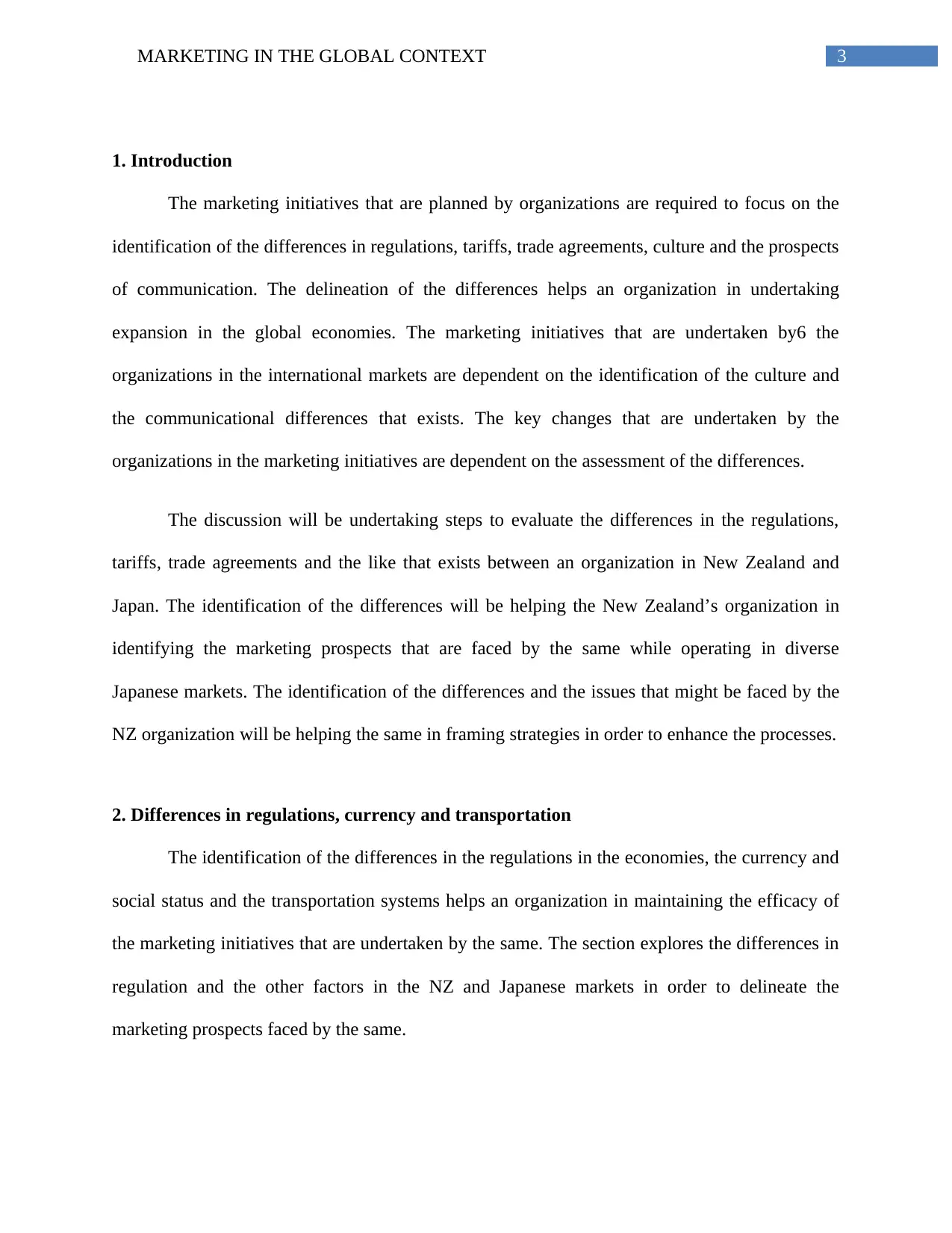
3MARKETING IN THE GLOBAL CONTEXT
1. Introduction
The marketing initiatives that are planned by organizations are required to focus on the
identification of the differences in regulations, tariffs, trade agreements, culture and the prospects
of communication. The delineation of the differences helps an organization in undertaking
expansion in the global economies. The marketing initiatives that are undertaken by6 the
organizations in the international markets are dependent on the identification of the culture and
the communicational differences that exists. The key changes that are undertaken by the
organizations in the marketing initiatives are dependent on the assessment of the differences.
The discussion will be undertaking steps to evaluate the differences in the regulations,
tariffs, trade agreements and the like that exists between an organization in New Zealand and
Japan. The identification of the differences will be helping the New Zealand’s organization in
identifying the marketing prospects that are faced by the same while operating in diverse
Japanese markets. The identification of the differences and the issues that might be faced by the
NZ organization will be helping the same in framing strategies in order to enhance the processes.
2. Differences in regulations, currency and transportation
The identification of the differences in the regulations in the economies, the currency and
social status and the transportation systems helps an organization in maintaining the efficacy of
the marketing initiatives that are undertaken by the same. The section explores the differences in
regulation and the other factors in the NZ and Japanese markets in order to delineate the
marketing prospects faced by the same.
1. Introduction
The marketing initiatives that are planned by organizations are required to focus on the
identification of the differences in regulations, tariffs, trade agreements, culture and the prospects
of communication. The delineation of the differences helps an organization in undertaking
expansion in the global economies. The marketing initiatives that are undertaken by6 the
organizations in the international markets are dependent on the identification of the culture and
the communicational differences that exists. The key changes that are undertaken by the
organizations in the marketing initiatives are dependent on the assessment of the differences.
The discussion will be undertaking steps to evaluate the differences in the regulations,
tariffs, trade agreements and the like that exists between an organization in New Zealand and
Japan. The identification of the differences will be helping the New Zealand’s organization in
identifying the marketing prospects that are faced by the same while operating in diverse
Japanese markets. The identification of the differences and the issues that might be faced by the
NZ organization will be helping the same in framing strategies in order to enhance the processes.
2. Differences in regulations, currency and transportation
The identification of the differences in the regulations in the economies, the currency and
social status and the transportation systems helps an organization in maintaining the efficacy of
the marketing initiatives that are undertaken by the same. The section explores the differences in
regulation and the other factors in the NZ and Japanese markets in order to delineate the
marketing prospects faced by the same.
Paraphrase This Document
Need a fresh take? Get an instant paraphrase of this document with our AI Paraphraser
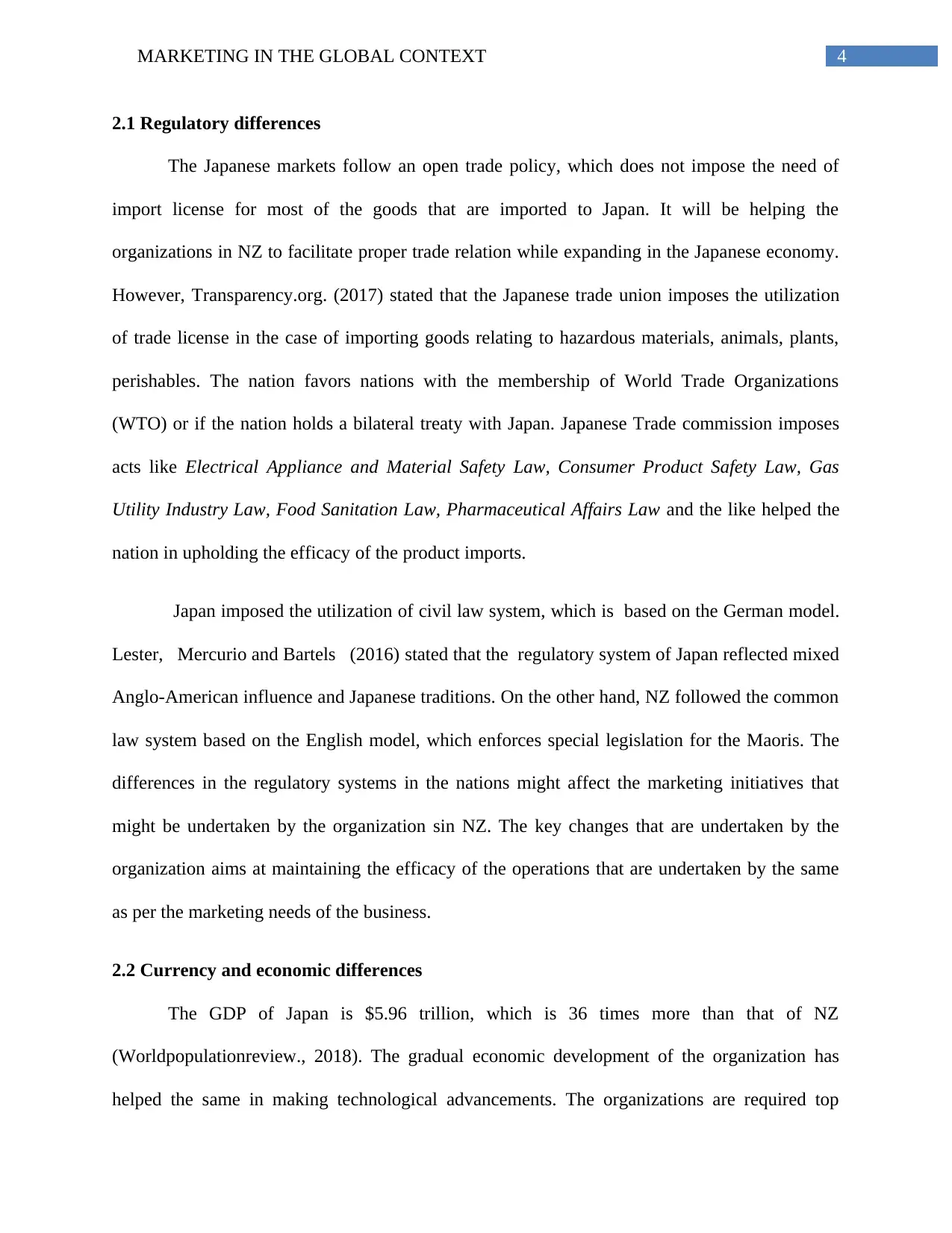
4MARKETING IN THE GLOBAL CONTEXT
2.1 Regulatory differences
The Japanese markets follow an open trade policy, which does not impose the need of
import license for most of the goods that are imported to Japan. It will be helping the
organizations in NZ to facilitate proper trade relation while expanding in the Japanese economy.
However, Transparency.org. (2017) stated that the Japanese trade union imposes the utilization
of trade license in the case of importing goods relating to hazardous materials, animals, plants,
perishables. The nation favors nations with the membership of World Trade Organizations
(WTO) or if the nation holds a bilateral treaty with Japan. Japanese Trade commission imposes
acts like Electrical Appliance and Material Safety Law, Consumer Product Safety Law, Gas
Utility Industry Law, Food Sanitation Law, Pharmaceutical Affairs Law and the like helped the
nation in upholding the efficacy of the product imports.
Japan imposed the utilization of civil law system, which is based on the German model.
Lester, Mercurio and Bartels (2016) stated that the regulatory system of Japan reflected mixed
Anglo-American influence and Japanese traditions. On the other hand, NZ followed the common
law system based on the English model, which enforces special legislation for the Maoris. The
differences in the regulatory systems in the nations might affect the marketing initiatives that
might be undertaken by the organization sin NZ. The key changes that are undertaken by the
organization aims at maintaining the efficacy of the operations that are undertaken by the same
as per the marketing needs of the business.
2.2 Currency and economic differences
The GDP of Japan is $5.96 trillion, which is 36 times more than that of NZ
(Worldpopulationreview., 2018). The gradual economic development of the organization has
helped the same in making technological advancements. The organizations are required top
2.1 Regulatory differences
The Japanese markets follow an open trade policy, which does not impose the need of
import license for most of the goods that are imported to Japan. It will be helping the
organizations in NZ to facilitate proper trade relation while expanding in the Japanese economy.
However, Transparency.org. (2017) stated that the Japanese trade union imposes the utilization
of trade license in the case of importing goods relating to hazardous materials, animals, plants,
perishables. The nation favors nations with the membership of World Trade Organizations
(WTO) or if the nation holds a bilateral treaty with Japan. Japanese Trade commission imposes
acts like Electrical Appliance and Material Safety Law, Consumer Product Safety Law, Gas
Utility Industry Law, Food Sanitation Law, Pharmaceutical Affairs Law and the like helped the
nation in upholding the efficacy of the product imports.
Japan imposed the utilization of civil law system, which is based on the German model.
Lester, Mercurio and Bartels (2016) stated that the regulatory system of Japan reflected mixed
Anglo-American influence and Japanese traditions. On the other hand, NZ followed the common
law system based on the English model, which enforces special legislation for the Maoris. The
differences in the regulatory systems in the nations might affect the marketing initiatives that
might be undertaken by the organization sin NZ. The key changes that are undertaken by the
organization aims at maintaining the efficacy of the operations that are undertaken by the same
as per the marketing needs of the business.
2.2 Currency and economic differences
The GDP of Japan is $5.96 trillion, which is 36 times more than that of NZ
(Worldpopulationreview., 2018). The gradual economic development of the organization has
helped the same in making technological advancements. The organizations are required top
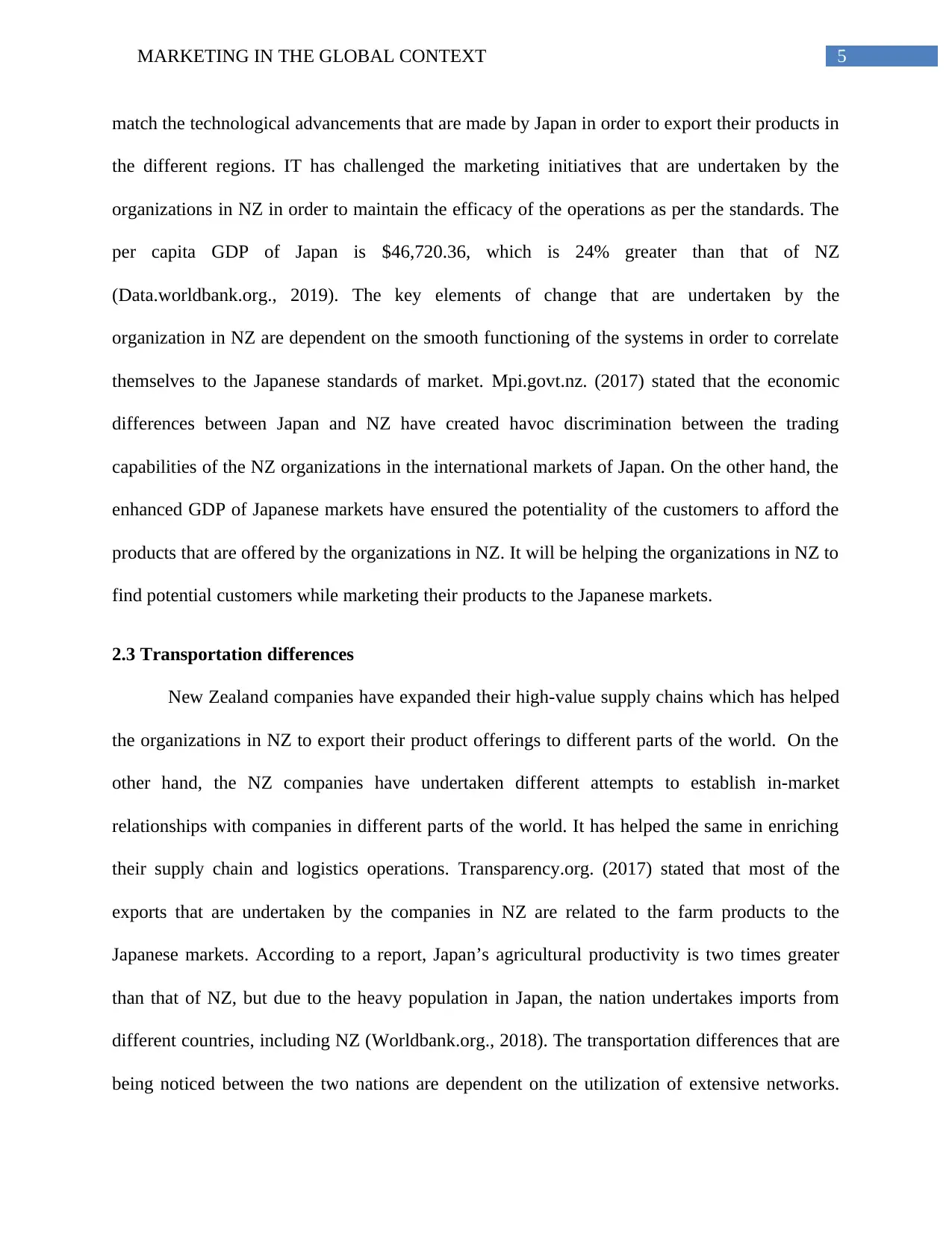
5MARKETING IN THE GLOBAL CONTEXT
match the technological advancements that are made by Japan in order to export their products in
the different regions. IT has challenged the marketing initiatives that are undertaken by the
organizations in NZ in order to maintain the efficacy of the operations as per the standards. The
per capita GDP of Japan is $46,720.36, which is 24% greater than that of NZ
(Data.worldbank.org., 2019). The key elements of change that are undertaken by the
organization in NZ are dependent on the smooth functioning of the systems in order to correlate
themselves to the Japanese standards of market. Mpi.govt.nz. (2017) stated that the economic
differences between Japan and NZ have created havoc discrimination between the trading
capabilities of the NZ organizations in the international markets of Japan. On the other hand, the
enhanced GDP of Japanese markets have ensured the potentiality of the customers to afford the
products that are offered by the organizations in NZ. It will be helping the organizations in NZ to
find potential customers while marketing their products to the Japanese markets.
2.3 Transportation differences
New Zealand companies have expanded their high-value supply chains which has helped
the organizations in NZ to export their product offerings to different parts of the world. On the
other hand, the NZ companies have undertaken different attempts to establish in-market
relationships with companies in different parts of the world. It has helped the same in enriching
their supply chain and logistics operations. Transparency.org. (2017) stated that most of the
exports that are undertaken by the companies in NZ are related to the farm products to the
Japanese markets. According to a report, Japan’s agricultural productivity is two times greater
than that of NZ, but due to the heavy population in Japan, the nation undertakes imports from
different countries, including NZ (Worldbank.org., 2018). The transportation differences that are
being noticed between the two nations are dependent on the utilization of extensive networks.
match the technological advancements that are made by Japan in order to export their products in
the different regions. IT has challenged the marketing initiatives that are undertaken by the
organizations in NZ in order to maintain the efficacy of the operations as per the standards. The
per capita GDP of Japan is $46,720.36, which is 24% greater than that of NZ
(Data.worldbank.org., 2019). The key elements of change that are undertaken by the
organization in NZ are dependent on the smooth functioning of the systems in order to correlate
themselves to the Japanese standards of market. Mpi.govt.nz. (2017) stated that the economic
differences between Japan and NZ have created havoc discrimination between the trading
capabilities of the NZ organizations in the international markets of Japan. On the other hand, the
enhanced GDP of Japanese markets have ensured the potentiality of the customers to afford the
products that are offered by the organizations in NZ. It will be helping the organizations in NZ to
find potential customers while marketing their products to the Japanese markets.
2.3 Transportation differences
New Zealand companies have expanded their high-value supply chains which has helped
the organizations in NZ to export their product offerings to different parts of the world. On the
other hand, the NZ companies have undertaken different attempts to establish in-market
relationships with companies in different parts of the world. It has helped the same in enriching
their supply chain and logistics operations. Transparency.org. (2017) stated that most of the
exports that are undertaken by the companies in NZ are related to the farm products to the
Japanese markets. According to a report, Japan’s agricultural productivity is two times greater
than that of NZ, but due to the heavy population in Japan, the nation undertakes imports from
different countries, including NZ (Worldbank.org., 2018). The transportation differences that are
being noticed between the two nations are dependent on the utilization of extensive networks.
⊘ This is a preview!⊘
Do you want full access?
Subscribe today to unlock all pages.

Trusted by 1+ million students worldwide
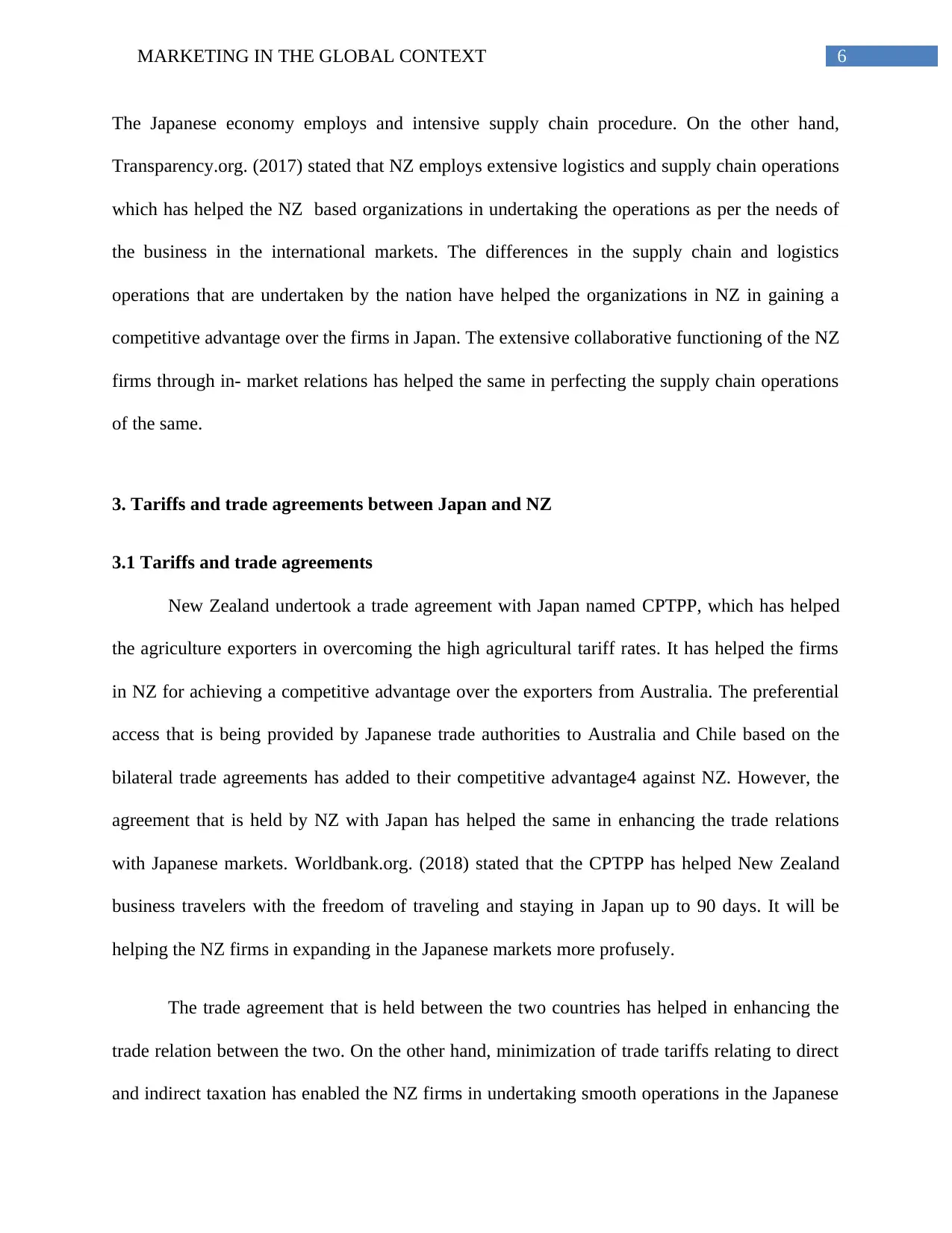
6MARKETING IN THE GLOBAL CONTEXT
The Japanese economy employs and intensive supply chain procedure. On the other hand,
Transparency.org. (2017) stated that NZ employs extensive logistics and supply chain operations
which has helped the NZ based organizations in undertaking the operations as per the needs of
the business in the international markets. The differences in the supply chain and logistics
operations that are undertaken by the nation have helped the organizations in NZ in gaining a
competitive advantage over the firms in Japan. The extensive collaborative functioning of the NZ
firms through in- market relations has helped the same in perfecting the supply chain operations
of the same.
3. Tariffs and trade agreements between Japan and NZ
3.1 Tariffs and trade agreements
New Zealand undertook a trade agreement with Japan named CPTPP, which has helped
the agriculture exporters in overcoming the high agricultural tariff rates. It has helped the firms
in NZ for achieving a competitive advantage over the exporters from Australia. The preferential
access that is being provided by Japanese trade authorities to Australia and Chile based on the
bilateral trade agreements has added to their competitive advantage4 against NZ. However, the
agreement that is held by NZ with Japan has helped the same in enhancing the trade relations
with Japanese markets. Worldbank.org. (2018) stated that the CPTPP has helped New Zealand
business travelers with the freedom of traveling and staying in Japan up to 90 days. It will be
helping the NZ firms in expanding in the Japanese markets more profusely.
The trade agreement that is held between the two countries has helped in enhancing the
trade relation between the two. On the other hand, minimization of trade tariffs relating to direct
and indirect taxation has enabled the NZ firms in undertaking smooth operations in the Japanese
The Japanese economy employs and intensive supply chain procedure. On the other hand,
Transparency.org. (2017) stated that NZ employs extensive logistics and supply chain operations
which has helped the NZ based organizations in undertaking the operations as per the needs of
the business in the international markets. The differences in the supply chain and logistics
operations that are undertaken by the nation have helped the organizations in NZ in gaining a
competitive advantage over the firms in Japan. The extensive collaborative functioning of the NZ
firms through in- market relations has helped the same in perfecting the supply chain operations
of the same.
3. Tariffs and trade agreements between Japan and NZ
3.1 Tariffs and trade agreements
New Zealand undertook a trade agreement with Japan named CPTPP, which has helped
the agriculture exporters in overcoming the high agricultural tariff rates. It has helped the firms
in NZ for achieving a competitive advantage over the exporters from Australia. The preferential
access that is being provided by Japanese trade authorities to Australia and Chile based on the
bilateral trade agreements has added to their competitive advantage4 against NZ. However, the
agreement that is held by NZ with Japan has helped the same in enhancing the trade relations
with Japanese markets. Worldbank.org. (2018) stated that the CPTPP has helped New Zealand
business travelers with the freedom of traveling and staying in Japan up to 90 days. It will be
helping the NZ firms in expanding in the Japanese markets more profusely.
The trade agreement that is held between the two countries has helped in enhancing the
trade relation between the two. On the other hand, minimization of trade tariffs relating to direct
and indirect taxation has enabled the NZ firms in undertaking smooth operations in the Japanese
Paraphrase This Document
Need a fresh take? Get an instant paraphrase of this document with our AI Paraphraser
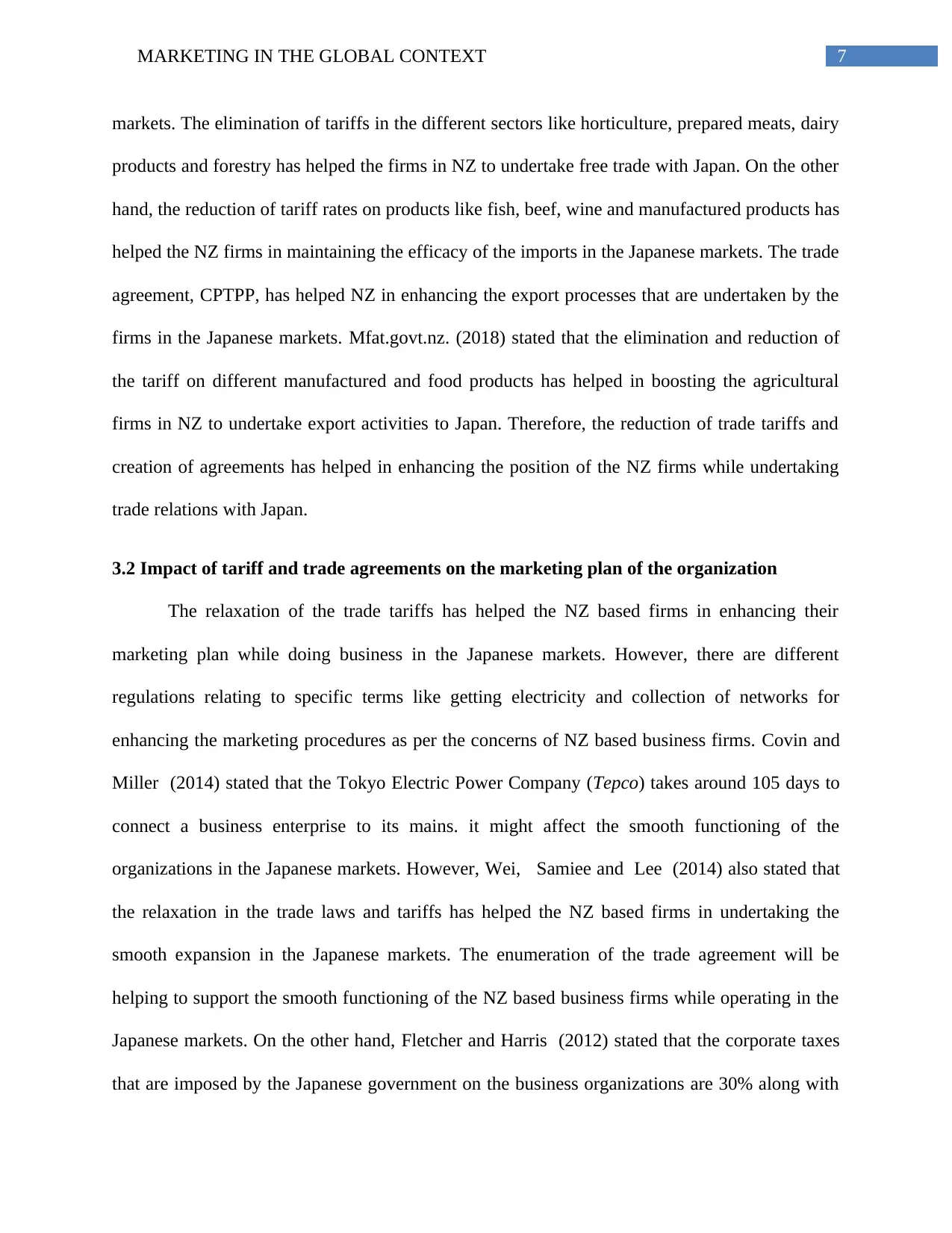
7MARKETING IN THE GLOBAL CONTEXT
markets. The elimination of tariffs in the different sectors like horticulture, prepared meats, dairy
products and forestry has helped the firms in NZ to undertake free trade with Japan. On the other
hand, the reduction of tariff rates on products like fish, beef, wine and manufactured products has
helped the NZ firms in maintaining the efficacy of the imports in the Japanese markets. The trade
agreement, CPTPP, has helped NZ in enhancing the export processes that are undertaken by the
firms in the Japanese markets. Mfat.govt.nz. (2018) stated that the elimination and reduction of
the tariff on different manufactured and food products has helped in boosting the agricultural
firms in NZ to undertake export activities to Japan. Therefore, the reduction of trade tariffs and
creation of agreements has helped in enhancing the position of the NZ firms while undertaking
trade relations with Japan.
3.2 Impact of tariff and trade agreements on the marketing plan of the organization
The relaxation of the trade tariffs has helped the NZ based firms in enhancing their
marketing plan while doing business in the Japanese markets. However, there are different
regulations relating to specific terms like getting electricity and collection of networks for
enhancing the marketing procedures as per the concerns of NZ based business firms. Covin and
Miller (2014) stated that the Tokyo Electric Power Company (Tepco) takes around 105 days to
connect a business enterprise to its mains. it might affect the smooth functioning of the
organizations in the Japanese markets. However, Wei, Samiee and Lee (2014) also stated that
the relaxation in the trade laws and tariffs has helped the NZ based firms in undertaking the
smooth expansion in the Japanese markets. The enumeration of the trade agreement will be
helping to support the smooth functioning of the NZ based business firms while operating in the
Japanese markets. On the other hand, Fletcher and Harris (2012) stated that the corporate taxes
that are imposed by the Japanese government on the business organizations are 30% along with
markets. The elimination of tariffs in the different sectors like horticulture, prepared meats, dairy
products and forestry has helped the firms in NZ to undertake free trade with Japan. On the other
hand, the reduction of tariff rates on products like fish, beef, wine and manufactured products has
helped the NZ firms in maintaining the efficacy of the imports in the Japanese markets. The trade
agreement, CPTPP, has helped NZ in enhancing the export processes that are undertaken by the
firms in the Japanese markets. Mfat.govt.nz. (2018) stated that the elimination and reduction of
the tariff on different manufactured and food products has helped in boosting the agricultural
firms in NZ to undertake export activities to Japan. Therefore, the reduction of trade tariffs and
creation of agreements has helped in enhancing the position of the NZ firms while undertaking
trade relations with Japan.
3.2 Impact of tariff and trade agreements on the marketing plan of the organization
The relaxation of the trade tariffs has helped the NZ based firms in enhancing their
marketing plan while doing business in the Japanese markets. However, there are different
regulations relating to specific terms like getting electricity and collection of networks for
enhancing the marketing procedures as per the concerns of NZ based business firms. Covin and
Miller (2014) stated that the Tokyo Electric Power Company (Tepco) takes around 105 days to
connect a business enterprise to its mains. it might affect the smooth functioning of the
organizations in the Japanese markets. However, Wei, Samiee and Lee (2014) also stated that
the relaxation in the trade laws and tariffs has helped the NZ based firms in undertaking the
smooth expansion in the Japanese markets. The enumeration of the trade agreement will be
helping to support the smooth functioning of the NZ based business firms while operating in the
Japanese markets. On the other hand, Fletcher and Harris (2012) stated that the corporate taxes
that are imposed by the Japanese government on the business organizations are 30% along with
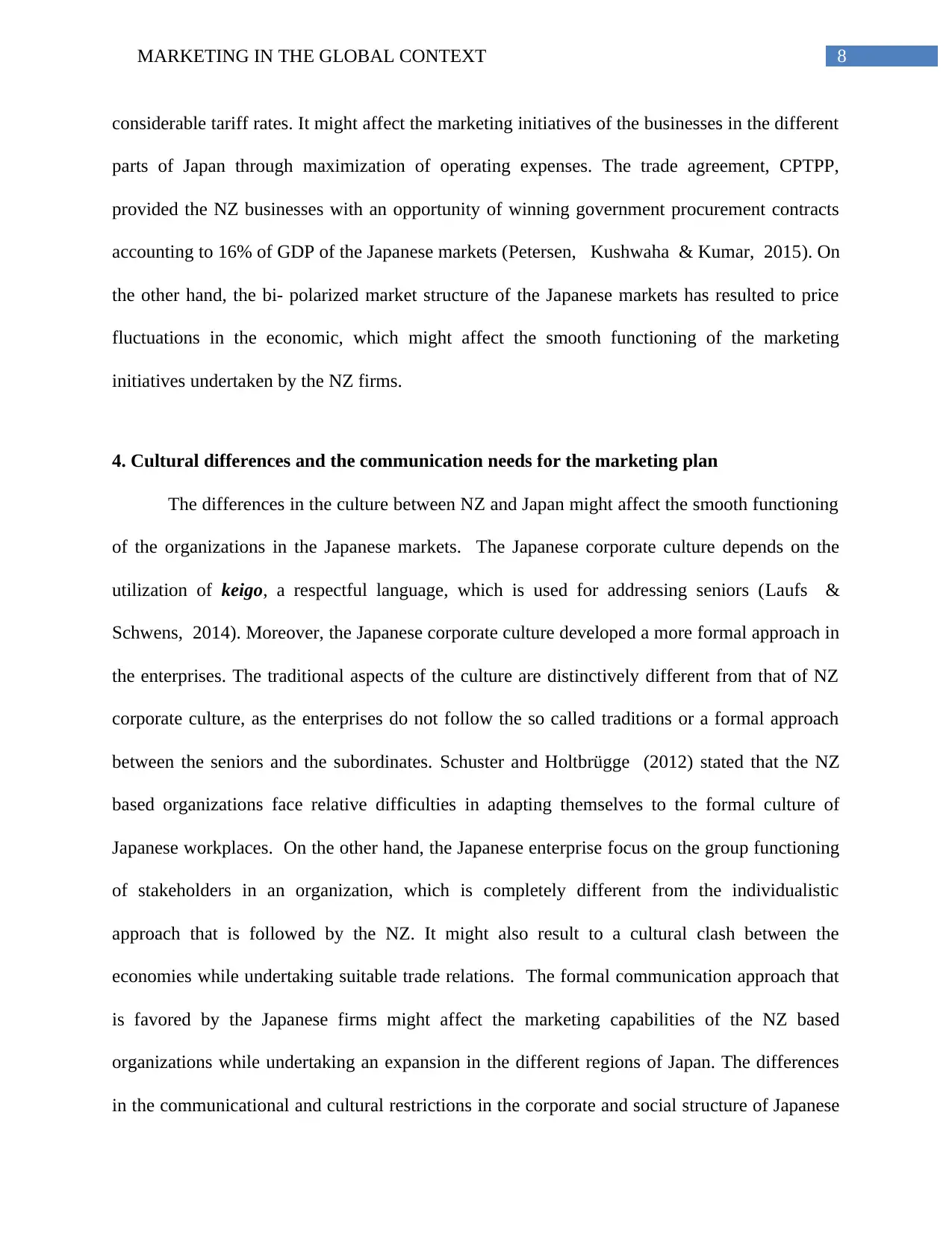
8MARKETING IN THE GLOBAL CONTEXT
considerable tariff rates. It might affect the marketing initiatives of the businesses in the different
parts of Japan through maximization of operating expenses. The trade agreement, CPTPP,
provided the NZ businesses with an opportunity of winning government procurement contracts
accounting to 16% of GDP of the Japanese markets (Petersen, Kushwaha & Kumar, 2015). On
the other hand, the bi- polarized market structure of the Japanese markets has resulted to price
fluctuations in the economic, which might affect the smooth functioning of the marketing
initiatives undertaken by the NZ firms.
4. Cultural differences and the communication needs for the marketing plan
The differences in the culture between NZ and Japan might affect the smooth functioning
of the organizations in the Japanese markets. The Japanese corporate culture depends on the
utilization of keigo, a respectful language, which is used for addressing seniors (Laufs &
Schwens, 2014). Moreover, the Japanese corporate culture developed a more formal approach in
the enterprises. The traditional aspects of the culture are distinctively different from that of NZ
corporate culture, as the enterprises do not follow the so called traditions or a formal approach
between the seniors and the subordinates. Schuster and Holtbrügge (2012) stated that the NZ
based organizations face relative difficulties in adapting themselves to the formal culture of
Japanese workplaces. On the other hand, the Japanese enterprise focus on the group functioning
of stakeholders in an organization, which is completely different from the individualistic
approach that is followed by the NZ. It might also result to a cultural clash between the
economies while undertaking suitable trade relations. The formal communication approach that
is favored by the Japanese firms might affect the marketing capabilities of the NZ based
organizations while undertaking an expansion in the different regions of Japan. The differences
in the communicational and cultural restrictions in the corporate and social structure of Japanese
considerable tariff rates. It might affect the marketing initiatives of the businesses in the different
parts of Japan through maximization of operating expenses. The trade agreement, CPTPP,
provided the NZ businesses with an opportunity of winning government procurement contracts
accounting to 16% of GDP of the Japanese markets (Petersen, Kushwaha & Kumar, 2015). On
the other hand, the bi- polarized market structure of the Japanese markets has resulted to price
fluctuations in the economic, which might affect the smooth functioning of the marketing
initiatives undertaken by the NZ firms.
4. Cultural differences and the communication needs for the marketing plan
The differences in the culture between NZ and Japan might affect the smooth functioning
of the organizations in the Japanese markets. The Japanese corporate culture depends on the
utilization of keigo, a respectful language, which is used for addressing seniors (Laufs &
Schwens, 2014). Moreover, the Japanese corporate culture developed a more formal approach in
the enterprises. The traditional aspects of the culture are distinctively different from that of NZ
corporate culture, as the enterprises do not follow the so called traditions or a formal approach
between the seniors and the subordinates. Schuster and Holtbrügge (2012) stated that the NZ
based organizations face relative difficulties in adapting themselves to the formal culture of
Japanese workplaces. On the other hand, the Japanese enterprise focus on the group functioning
of stakeholders in an organization, which is completely different from the individualistic
approach that is followed by the NZ. It might also result to a cultural clash between the
economies while undertaking suitable trade relations. The formal communication approach that
is favored by the Japanese firms might affect the marketing capabilities of the NZ based
organizations while undertaking an expansion in the different regions of Japan. The differences
in the communicational and cultural restrictions in the corporate and social structure of Japanese
⊘ This is a preview!⊘
Do you want full access?
Subscribe today to unlock all pages.

Trusted by 1+ million students worldwide
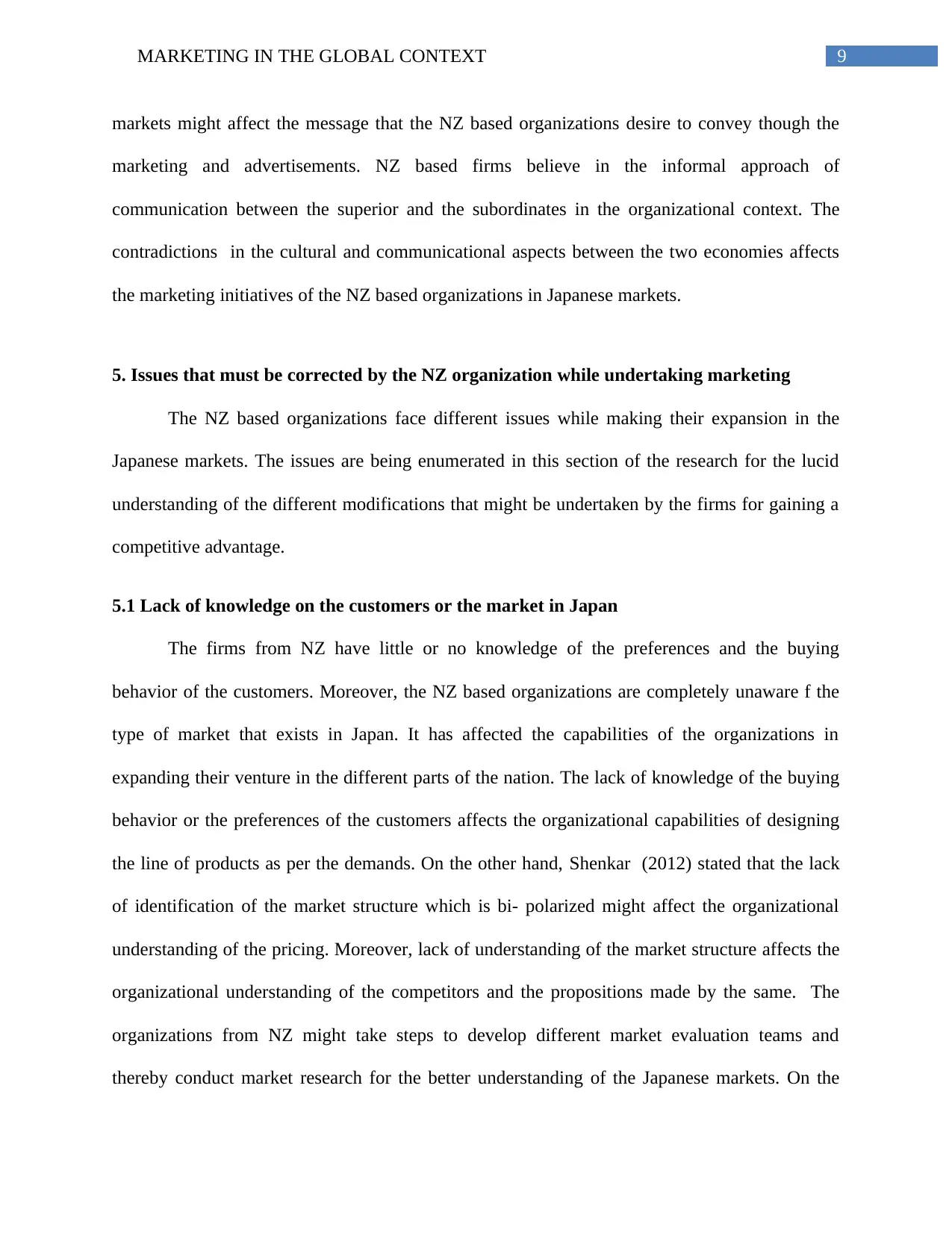
9MARKETING IN THE GLOBAL CONTEXT
markets might affect the message that the NZ based organizations desire to convey though the
marketing and advertisements. NZ based firms believe in the informal approach of
communication between the superior and the subordinates in the organizational context. The
contradictions in the cultural and communicational aspects between the two economies affects
the marketing initiatives of the NZ based organizations in Japanese markets.
5. Issues that must be corrected by the NZ organization while undertaking marketing
The NZ based organizations face different issues while making their expansion in the
Japanese markets. The issues are being enumerated in this section of the research for the lucid
understanding of the different modifications that might be undertaken by the firms for gaining a
competitive advantage.
5.1 Lack of knowledge on the customers or the market in Japan
The firms from NZ have little or no knowledge of the preferences and the buying
behavior of the customers. Moreover, the NZ based organizations are completely unaware f the
type of market that exists in Japan. It has affected the capabilities of the organizations in
expanding their venture in the different parts of the nation. The lack of knowledge of the buying
behavior or the preferences of the customers affects the organizational capabilities of designing
the line of products as per the demands. On the other hand, Shenkar (2012) stated that the lack
of identification of the market structure which is bi- polarized might affect the organizational
understanding of the pricing. Moreover, lack of understanding of the market structure affects the
organizational understanding of the competitors and the propositions made by the same. The
organizations from NZ might take steps to develop different market evaluation teams and
thereby conduct market research for the better understanding of the Japanese markets. On the
markets might affect the message that the NZ based organizations desire to convey though the
marketing and advertisements. NZ based firms believe in the informal approach of
communication between the superior and the subordinates in the organizational context. The
contradictions in the cultural and communicational aspects between the two economies affects
the marketing initiatives of the NZ based organizations in Japanese markets.
5. Issues that must be corrected by the NZ organization while undertaking marketing
The NZ based organizations face different issues while making their expansion in the
Japanese markets. The issues are being enumerated in this section of the research for the lucid
understanding of the different modifications that might be undertaken by the firms for gaining a
competitive advantage.
5.1 Lack of knowledge on the customers or the market in Japan
The firms from NZ have little or no knowledge of the preferences and the buying
behavior of the customers. Moreover, the NZ based organizations are completely unaware f the
type of market that exists in Japan. It has affected the capabilities of the organizations in
expanding their venture in the different parts of the nation. The lack of knowledge of the buying
behavior or the preferences of the customers affects the organizational capabilities of designing
the line of products as per the demands. On the other hand, Shenkar (2012) stated that the lack
of identification of the market structure which is bi- polarized might affect the organizational
understanding of the pricing. Moreover, lack of understanding of the market structure affects the
organizational understanding of the competitors and the propositions made by the same. The
organizations from NZ might take steps to develop different market evaluation teams and
thereby conduct market research for the better understanding of the Japanese markets. On the
Paraphrase This Document
Need a fresh take? Get an instant paraphrase of this document with our AI Paraphraser
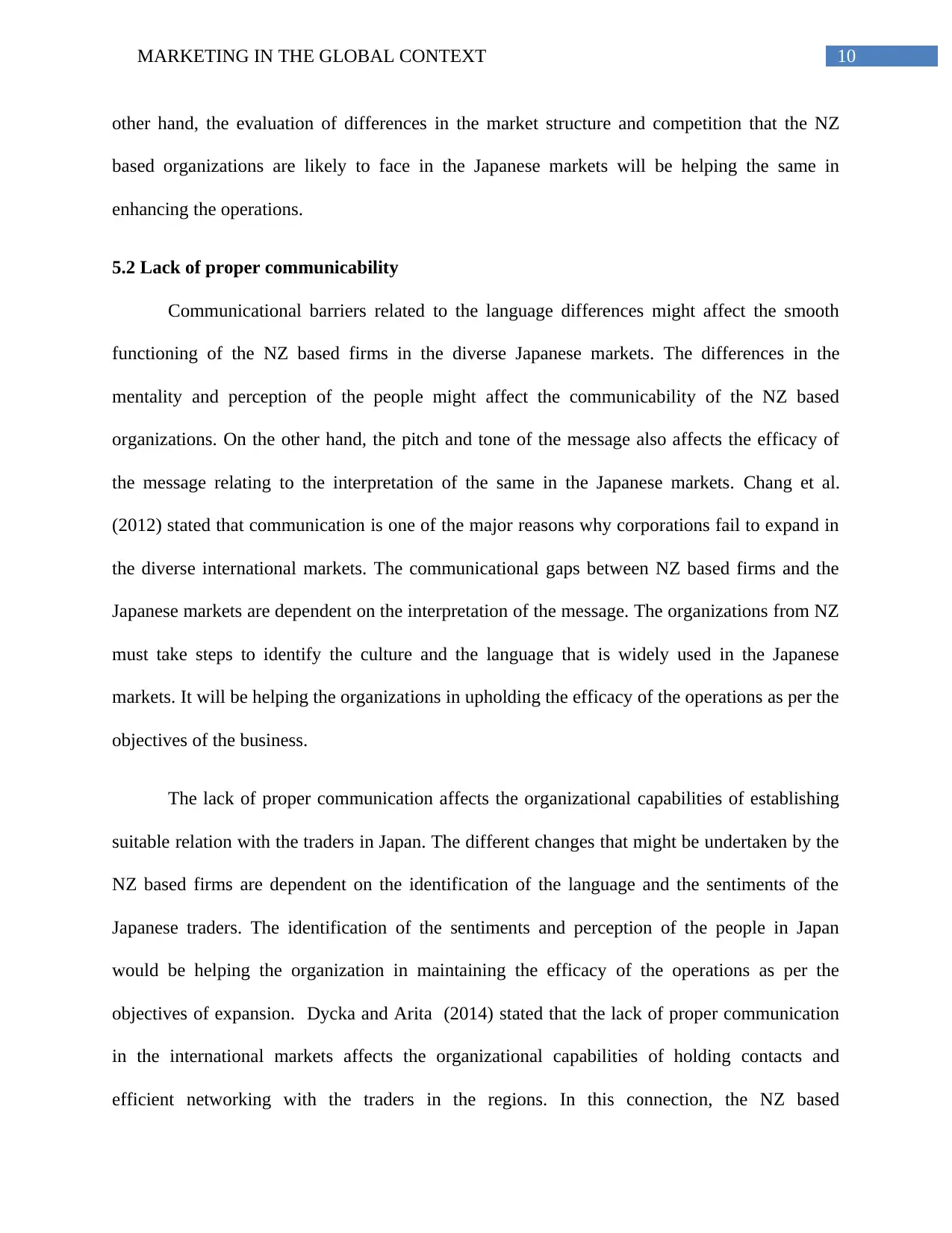
10MARKETING IN THE GLOBAL CONTEXT
other hand, the evaluation of differences in the market structure and competition that the NZ
based organizations are likely to face in the Japanese markets will be helping the same in
enhancing the operations.
5.2 Lack of proper communicability
Communicational barriers related to the language differences might affect the smooth
functioning of the NZ based firms in the diverse Japanese markets. The differences in the
mentality and perception of the people might affect the communicability of the NZ based
organizations. On the other hand, the pitch and tone of the message also affects the efficacy of
the message relating to the interpretation of the same in the Japanese markets. Chang et al.
(2012) stated that communication is one of the major reasons why corporations fail to expand in
the diverse international markets. The communicational gaps between NZ based firms and the
Japanese markets are dependent on the interpretation of the message. The organizations from NZ
must take steps to identify the culture and the language that is widely used in the Japanese
markets. It will be helping the organizations in upholding the efficacy of the operations as per the
objectives of the business.
The lack of proper communication affects the organizational capabilities of establishing
suitable relation with the traders in Japan. The different changes that might be undertaken by the
NZ based firms are dependent on the identification of the language and the sentiments of the
Japanese traders. The identification of the sentiments and perception of the people in Japan
would be helping the organization in maintaining the efficacy of the operations as per the
objectives of expansion. Dycka and Arita (2014) stated that the lack of proper communication
in the international markets affects the organizational capabilities of holding contacts and
efficient networking with the traders in the regions. In this connection, the NZ based
other hand, the evaluation of differences in the market structure and competition that the NZ
based organizations are likely to face in the Japanese markets will be helping the same in
enhancing the operations.
5.2 Lack of proper communicability
Communicational barriers related to the language differences might affect the smooth
functioning of the NZ based firms in the diverse Japanese markets. The differences in the
mentality and perception of the people might affect the communicability of the NZ based
organizations. On the other hand, the pitch and tone of the message also affects the efficacy of
the message relating to the interpretation of the same in the Japanese markets. Chang et al.
(2012) stated that communication is one of the major reasons why corporations fail to expand in
the diverse international markets. The communicational gaps between NZ based firms and the
Japanese markets are dependent on the interpretation of the message. The organizations from NZ
must take steps to identify the culture and the language that is widely used in the Japanese
markets. It will be helping the organizations in upholding the efficacy of the operations as per the
objectives of the business.
The lack of proper communication affects the organizational capabilities of establishing
suitable relation with the traders in Japan. The different changes that might be undertaken by the
NZ based firms are dependent on the identification of the language and the sentiments of the
Japanese traders. The identification of the sentiments and perception of the people in Japan
would be helping the organization in maintaining the efficacy of the operations as per the
objectives of expansion. Dycka and Arita (2014) stated that the lack of proper communication
in the international markets affects the organizational capabilities of holding contacts and
efficient networking with the traders in the regions. In this connection, the NZ based
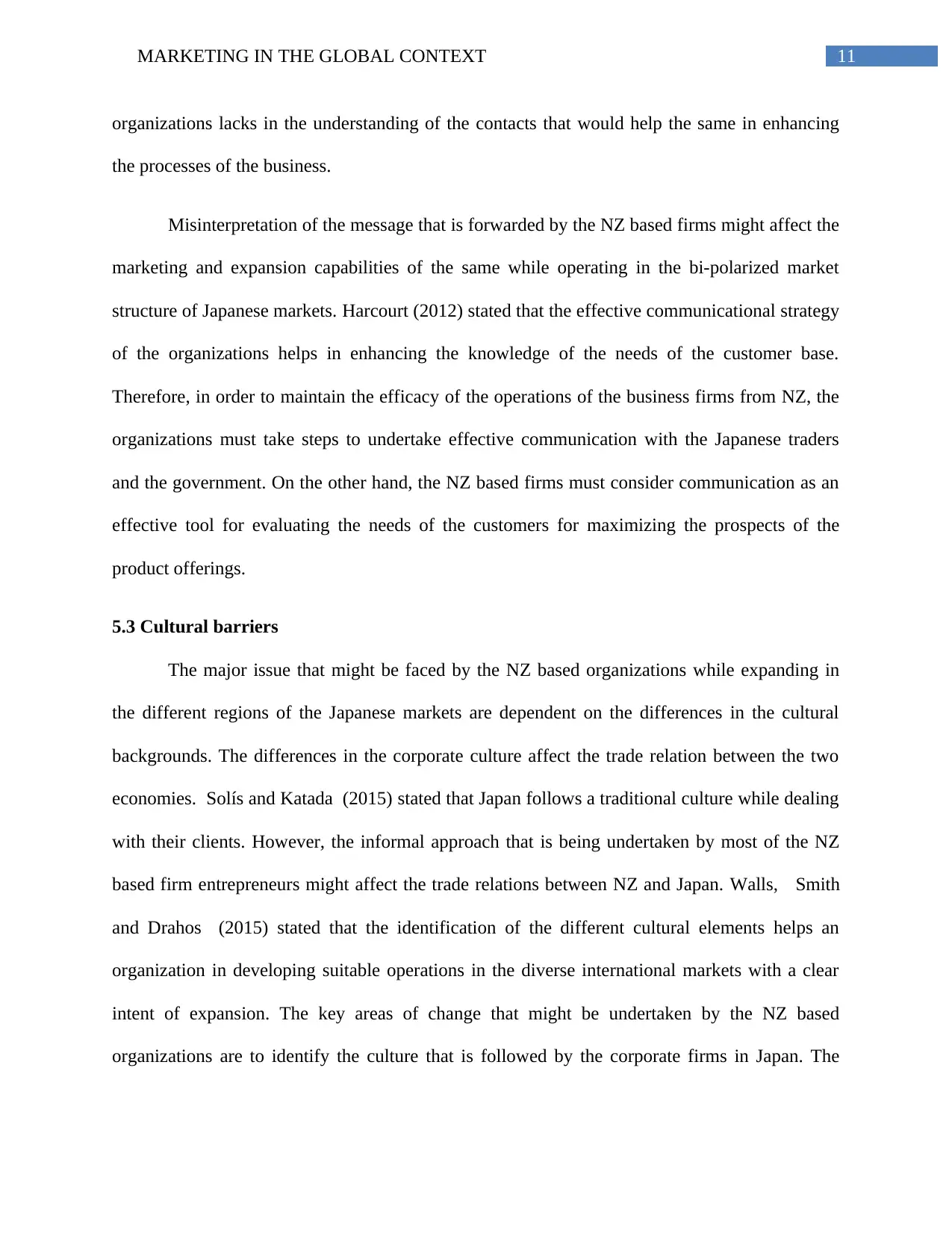
11MARKETING IN THE GLOBAL CONTEXT
organizations lacks in the understanding of the contacts that would help the same in enhancing
the processes of the business.
Misinterpretation of the message that is forwarded by the NZ based firms might affect the
marketing and expansion capabilities of the same while operating in the bi-polarized market
structure of Japanese markets. Harcourt (2012) stated that the effective communicational strategy
of the organizations helps in enhancing the knowledge of the needs of the customer base.
Therefore, in order to maintain the efficacy of the operations of the business firms from NZ, the
organizations must take steps to undertake effective communication with the Japanese traders
and the government. On the other hand, the NZ based firms must consider communication as an
effective tool for evaluating the needs of the customers for maximizing the prospects of the
product offerings.
5.3 Cultural barriers
The major issue that might be faced by the NZ based organizations while expanding in
the different regions of the Japanese markets are dependent on the differences in the cultural
backgrounds. The differences in the corporate culture affect the trade relation between the two
economies. Solís and Katada (2015) stated that Japan follows a traditional culture while dealing
with their clients. However, the informal approach that is being undertaken by most of the NZ
based firm entrepreneurs might affect the trade relations between NZ and Japan. Walls, Smith
and Drahos (2015) stated that the identification of the different cultural elements helps an
organization in developing suitable operations in the diverse international markets with a clear
intent of expansion. The key areas of change that might be undertaken by the NZ based
organizations are to identify the culture that is followed by the corporate firms in Japan. The
organizations lacks in the understanding of the contacts that would help the same in enhancing
the processes of the business.
Misinterpretation of the message that is forwarded by the NZ based firms might affect the
marketing and expansion capabilities of the same while operating in the bi-polarized market
structure of Japanese markets. Harcourt (2012) stated that the effective communicational strategy
of the organizations helps in enhancing the knowledge of the needs of the customer base.
Therefore, in order to maintain the efficacy of the operations of the business firms from NZ, the
organizations must take steps to undertake effective communication with the Japanese traders
and the government. On the other hand, the NZ based firms must consider communication as an
effective tool for evaluating the needs of the customers for maximizing the prospects of the
product offerings.
5.3 Cultural barriers
The major issue that might be faced by the NZ based organizations while expanding in
the different regions of the Japanese markets are dependent on the differences in the cultural
backgrounds. The differences in the corporate culture affect the trade relation between the two
economies. Solís and Katada (2015) stated that Japan follows a traditional culture while dealing
with their clients. However, the informal approach that is being undertaken by most of the NZ
based firm entrepreneurs might affect the trade relations between NZ and Japan. Walls, Smith
and Drahos (2015) stated that the identification of the different cultural elements helps an
organization in developing suitable operations in the diverse international markets with a clear
intent of expansion. The key areas of change that might be undertaken by the NZ based
organizations are to identify the culture that is followed by the corporate firms in Japan. The
⊘ This is a preview!⊘
Do you want full access?
Subscribe today to unlock all pages.

Trusted by 1+ million students worldwide
1 out of 17
Related Documents
Your All-in-One AI-Powered Toolkit for Academic Success.
+13062052269
info@desklib.com
Available 24*7 on WhatsApp / Email
![[object Object]](/_next/static/media/star-bottom.7253800d.svg)
Unlock your academic potential
Copyright © 2020–2025 A2Z Services. All Rights Reserved. Developed and managed by ZUCOL.





